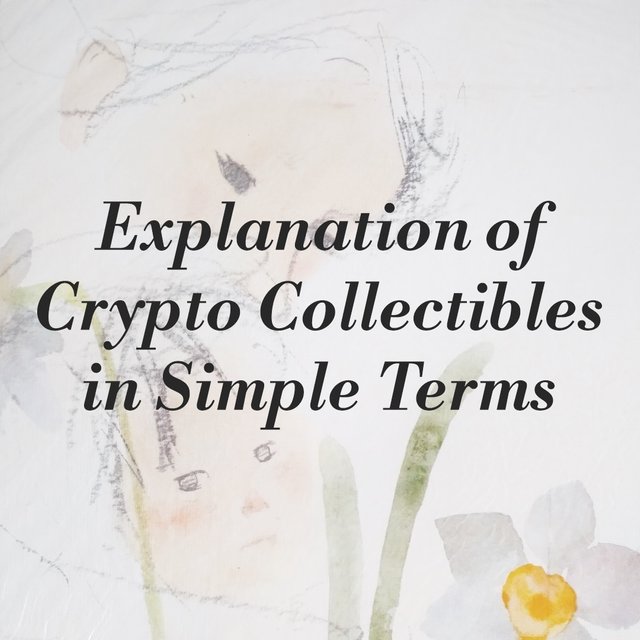Explanation of Crypto Collectibles in Simple Terms
The buzz of the town over the previous several months has been digital or "crypto collectibles." Decentraland defines crypto collectibles as: A crypto collectible is a cryptographically unique, non-fungible digital asset. Unlike cryptocurrencies, where all tokens must be similar, each crypto collectible token is unique or restricted in quantity.

#Cryptocollectibles are frequently shown as real world things like as pets or avatars. Each token differs in particular properties, and the number of tokens that may be created is limited.
What exactly does it mean for anything to be digitally scarce?
The primary reason that digital collectibles are even conceivable can be traced back to Bitcoin, which was the first to demonstrate that trust-free digital scarcity is possible.
The reason why digital scarcity is so astonishing is because digital assets (which are just made up of software code) tend to be abundant. While the cost of copying things in the physical world is significant, the cost of replicating them in the digital world is simply a typing copy paste exercise (just ask the music companies).
The term trustless digital scarcity refers to Bitcoin's fixed supply (unchangeable and enforced by code) that is hard to alter, regardless of the objectives of the opponent or business seeking to change it. There will always be 21 million bitcoin, which is a well-known statistic that we may take confidence in.
In addition to being rare Bitcoin is frequently referred to as fungible.
Fungibility is also known as:
the location of the item or a commodity whose constituent units are virtually interchangeable
Fungibility and scarcity are two of the five qualities of currencies that are commonly mentioned.
Is gold fungible? An ounce of pure gold is identical to any other ounce of pure gold. It's also rare,
considering that we need to remove a presumably set amount from the earth.
In terms of collectibles, fresh new baseballs are fungible (essentially interchangeable) until the first is signed by Babe Ruth, at which point it becomes a separate collectable.
As cash, a fungible, scarce digital token that you may share with others offers great usefulness. However, inside the collectable context, what if we held many of the same features but tagged tokens with unique identifiers (metadata, for your geeks) to ensure that we could distinguish between two tokens of the same kind? Non-fungible tokens are Picassos, Van Goghs, and Rembrandts, but fungible tokens are similar blank canvases.
The simple answer is that you receive non-fungible tokens (a.k.a. NFTs), a considerably more technical term some people use to describe crypto collectibles.
What does this mean for the development of other collectibles?
While there have been several prior approaches for generating digital collectibles, such as Rare Pepe cards based on Counterparty's blockchain, none of them have been adopted by a general audience.
The CryptoKitties project, which began on November 28th, 2017,
was the first non-fungible token to get substantial attention. It captured everyone's imagination and massive sums of money, almost taking the Ethereum blockchain along with it.On the Ethereum blockchain, individuals have spent more than $1 million for virtual animals. CryptoKitties is a digital version of Pokemon cards that was created a few years ago.
Where do we go from here?
Numerous non-fungible tokens have begun to emerge since the introduction of CryptoKitties.
Decentraland is one of my personal favorite examples.Decentraland is a virtual reality platform that runs on the Ethereum blockchain. Users may create, use, and monetize content and apps.
Unlike previous virtual reality worlds, Decentraland is establishing a
truly decentralized virtual reality realm that is entirely owned by consumers. They're making extensive use of the non-fungible in this process, from inventing in-world games to selling a lot of virtual land.
Why Is Decentraland Fighting Centralized VR Worlds?
While Decentraland is pursuing an extremely ambitious, utopian goal,
it will not be long until real-world assets are represented ization sold using non-fungible tokens.
Because the common format of these tokens allows for swift trading and shared liquidity,
this virtual representation has already been created for art and hard assets:
RareBits has created a market for various distinct digital valuables.
Despite the fact that many digitally-native tokens are fads, this isn't that different from other (non-digital) collectibles.
The cultural value assigned to pure collectibles will fluctuate, but with the future adoption of non-fungible tokens in traditional games
and new types of assets being represented as NFTs, I anticipate that the growth and development of crypto collectibles will continue
to be influential in the future.
Your post was upvoted and resteemed on @crypto.defrag